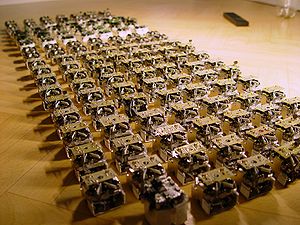
Nikola Tesla with his invention, a wireless lightbulb powered by the electric field surrounding it. (Photo credit: Wikipedia)
Inexpensive technology means that anyone can easily transform an idea into a product.
From Ben Franklin to Steve Jobs, America has always been a land of inventors and tinkerers, according to Adam Davidson, economic columnist for The New York Times Magazine. But it wasn’t always easy.
“In the past, someone with a new idea would have had to actually build the thing themselves, find a market for it and figure out how to get it mass-produced.”
Inventors today, however, have access to resources that their predecessors couldn’t have imagined. Inexpensive technology means that anyone can easily transform an idea into a product.
At a recent Inventors Association of Manhattan meeting, Cheryl Manzone shows off her latest innovation Stickpods, which looks like a straw with legs and is used for holding lollipops. Chris Landano, a young firefighter talks about his TrakPak360, a utility belt for tools.
So does this qualify today’s innovation landscape as a Golden Age for the U.S.? Davidson says no.
“The new-idea supply chain has some considerable rough patches that, in many ways, are harder to overcome than ever. Once invented and prototyped, those new products have to compete for space in a very narrow pipeline. Retail has become so concentrated that three companies (Walmart, Kroger and Target) control about a fifth of all United States in-store sales, and a tiny number of Internet and made-for-TV giants (Amazon, QVC) dominate in-home sales.”
Patents for inventions are also expensive. At an average of $10,000 for a patent, the obstacles are stacked against the ordinary inventor who might be working out of his basement.
Bookmark this page for “Golden Age For Inventors” and check back regularly as these articles update on a very frequent basis. The view is set to “news”. Try clicking on “video” and “2” for more articles.







